[Note: This is part one of a two-part article. You can find part two here]
If you were to write a history of the Portland coffee scene, the story would not be complete without a visit to Kobos Coffee. Founded in 1973 by David and Susan Kobos, Kobos Coffee was one of the first companies in the area to roast its own coffee, and has since grown into one of the largest coffee roasters in Portland.
Without knowing any of the company’s history, the first time I went to Kobos, I was surprised to walk into the company’s Vaughn Street café and be surrounded by what looked like the kitchen department at Macy’s. In addition to lots of coffee paraphernalia and an espresso bar, there was lots of brightly-lit and brightly-colored kitchen gadgetry, including dishes, linens and other housewares.
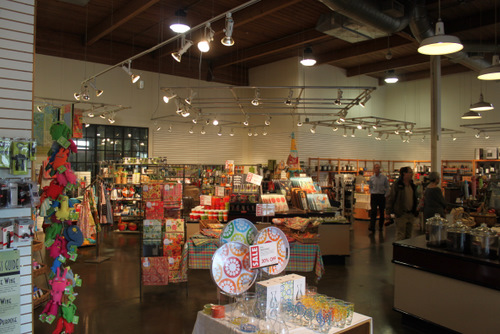
I wanted to find out what the story was, so after “meeting” Kobos’ Kevin Dibble in Twitterspace, we arranged a time to meet and talk about the company’s operations. When I arrived at the store, Kevin, who is also one of Kobos’ roasters, greeted me and took me back to the offices. He introduced me to Brian Dibble, his father and co-owner of Kobos. Together, they led me through the roasting plant and told me about the company’s operations.
Our first stop on the tour was the coffee warehouse. It was spacious, with pallets piled up with large burlap sacks full of green coffee beans. Brian said that there were about twenty different origins and varieties represented in the warehouse. He said that Kobos roasts about 40,000 pounds of coffee each month. That’s a lot of coffee, and it goes to a lot of different places.

In addition to the Kobos brand, Kobos also labels some of its coffee for other causes, like the Best Friend Blend, which supports the Oregon Humane Socieity. Some of the coffee is sold in Kobos’ two cafés, on Vaughn Street and at 200 SW Market street, inside a large office building. The company also provides full coffee service for offices and restaurants. This includes brewing equipment, and Kobos employs a full-time maintenance person to make sure that customers’ machines are always up and running. If one breaks down, they can usually get it fixed on the same day.
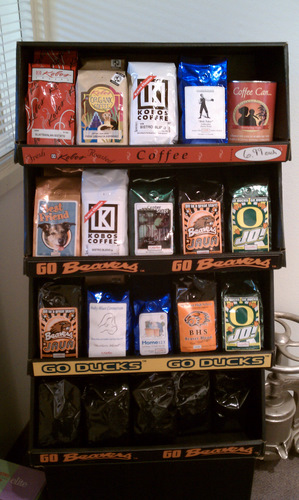 A selection of Kobos' coffees. Photo courtesy Brian Dibble
A selection of Kobos' coffees. Photo courtesy Brian Dibble
The roasting equipment at Kobos was larger than other roasters I have visited. The main roaster, an old gray-colored Probat that looks like a small locomotive, is designed to roast up to 132 pounds (60kg) of coffee at once, though it can accommodate 150 pounds if needed. The steel on the machine is thick and it maintains a nice even temperature throughout the roasting process. Kobos does have a second, smaller roaster, but the larger one gets the bulk of the use.
During the roasting process, coffee gives off lots of smoke, and roasting nearly half a million pounds of coffee each year in an urban area can create problems with the neighbors if you are not careful. Kobos is on the edge of the Northwest Industrial district, but there are two hotels just down the street from the plant and a residential area to the south, so Brian designed a high-powered afterburner to remove most of the smoke leaving the plant.
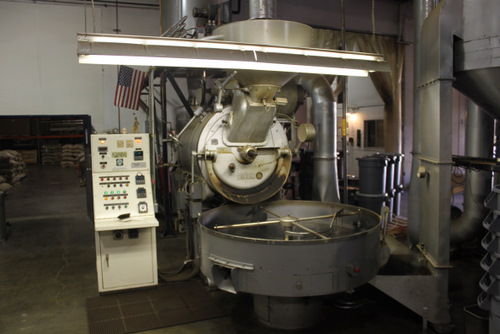
“The smell of roasting coffee doesn’t bother most people,” he told me, “but it only takes one or two people to complain and it becomes a real issue. So far, we haven’t had any problems.”
After the coffee is roasted, it passes through a de-stoner to make sure that there are not any rocks in the finished coffee. The machine separates out any stones that may be in the coffee, saving the burrs of any unsuspecting grinder that may come across them. Kevin pointed out what they call the company’s rock collection, a glass jar filled with 20+ years’ worth of small rocks. They do not find many rocks in the coffee, but over time the amount adds up.
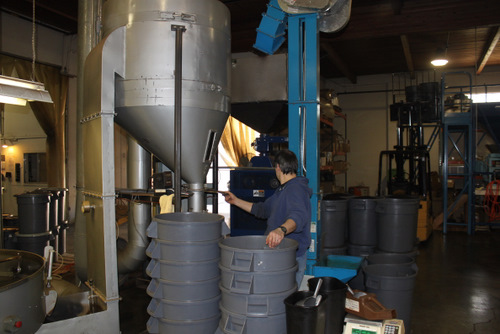
Once through the de-stoner, the roasted coffee is put into large gray tubs until it is ready for blending or grinding. Because Kobos provides so much of its coffee to offices and restaurants, approximately 50% of the coffee they produce is pre-ground before it is packaged.
The coffee in the tubs seemed pretty dark, so I asked Brian and Kevin about their typical roasting profile. They said that contrary to the trend among some of Portland’s micro-roasters, most of Kobos’ restaurant account customers prefer a darker roast. Brian’s theory is that over the last couple decades, the ubiquity of Starbucks’ coffee has trained people to expect a darker roast. For better or worse, people want the consistency that a darker roast offers.
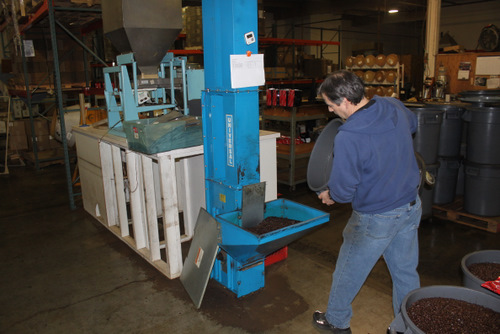
I asked Brian how he first got into coffee. He told me that about 30 years ago, he started dating the niece of another local roaster and got a job working for her uncle. The courtship didn’t last, but his love of coffee and roasting did. He worked for the roaster for about nine years before moving over to Kobos in 1989 as a production/roasting manager. From the beginning, Brian and David Kobos hit it off well. When Dibble first came to Kobos, David Kobos came out to watch him roast one batch, realized he was working with someone who knew what he was doing, and went back to his office, fully confident he had hired the right person. A couple years later, Dibble also took over the buying duties too. In 2001, he became part-owner of the company.
After our tour of the roasting facility, Kevin went back to work in the plant and Brian and I went back to the offices to talk while waiting for David Kobos to arrive. One of the topics that came up was the challenge of high coffee prices and the impact they were having on business. The high prices do make him nervous as a business owner, especially because Kobos has 31 employees to think about.
“It’s one thing if you only have to worry about taking care of yourself,” he said. “You can always tighten up your own personal budget. But when you have 31 employees, with benefits and things, it adds pressure to be profitable. You care about your people and you want to do as much as you can for them.”
While the current high prices are a problem, Brian said that there has always been these types of challenges to overcome. When he first started in coffee, for example, customers did not want to pay more for a better cup of coffee.
“Back then,” he said, referring to his early days in the industry, “you were up against the mindset of coffee being cheap, mainly because in the 50s and 60s, even into the 70s, coffee was a loss leader for the grocery stores. I don’t know why the trend got started, but it was like that. They perpetuated it for so long that people just expected it. Kobos, CBI [Coffee Bean International] and others had to convince customers there was a difference.”
Dibble expects prices to come back down because he believes that there is a lot of speculation in the markets and he also said that farmers are planting more and more coffee trees, which will eventually increase the supply.
In addition to prices, we also discussed some of the social issues related to coffee production. We talked about direct-trade and fair-trade coffee as well as the impact of urbanization in developing countries. He says that in his position, as a small to medium-sized buyer, the direct-trade model is not very practical. It is difficult to walk up to a single farmer in a country and say that Kobos wants to buy that farmer’s coffee, because one farmers’ coffee would make up such a small percentage of Kobos’ needs. He would not have time to visit and negotiate with each farmer.
While he may not buy directly from individual farmers, he is concerned that farmers receive a fair price for their coffee. He buys a significant amount of FairTrade-certified beans, and all of Kobos’ organic coffees, which make up about 30% of company sales, are fair-trade certified by TransFair (now FairTrade USA).
Kobos also is a supporter of Café Feminino, a cooperative of women coffee farmers who are working to improve the quality of life for people in rural Peru and other coffee producing countries. Café Femenino growers are paid a premium for their coffee over market prices. In addition, Café Femenino’s supporters raise money to fund projects in the communities where the cooperative operates. The women get together and decide what needs to be done, and the foundation helps fund it. Dibble believes passionately in Café Femenino’s mission and is a volunteer board member.
Another issue of importance in the coffee industry is the impact that urbanization is having on coffee-growing communities. Kobos gets much of its coffee from Peru, and Dibble has visited the same cooperatives in Peru multiple times. Each time he goes back, he sees the changes that are taking place in the country.
On his last trip, he was surprised when he came across some kids watching American monster truck races on satellite television. He noted how the technology available in these areas has changed rapidly since the first time he visited. These days, information from the rest of the world is reaching farmers in the Andes and other remote regions. Dibble wondered what the long-term effects will be on coffee-growing regions.
“It will be interesting to see over the long haul what kind of impact [the modernization] has,” he said. “In one sense, the economic development is a good thing, but on the other hand, we just don’t know how it will play out.”
He was referring to the fact that since the younger generation can see the lifestyles of people living in the cities, they will leave the farms to look for a better life. As the migration to the cities increases, there will be fewer people to grow the coffee.
We have already seen this play out in other countries. The rural-to-urban shift took place in America last century without disrupting agricultural production, but there is one important difference. Unlike wheat, corn and many other crops, coffee is not well-suited for large-scale mechanization. Much of the land is too steep to support large equipment, and high-quality coffee needs to be hand-picked because it ripens at different times on the branches. A loss of population in coffee-growing areas could significantly hurt production.
About this time, David Kobos came in to talk. He greeted me warmly and we sat down at the table. I asked him to tell me about the history of his store, and with the gleam in his eye of someone who likes to tell a good story, Kobos enthusiastically recounted it.